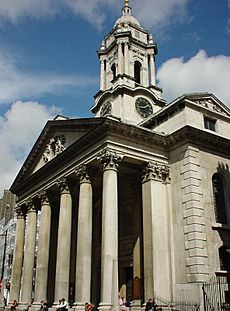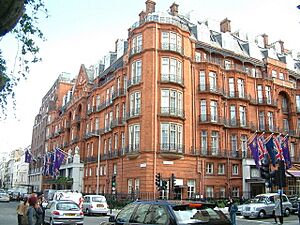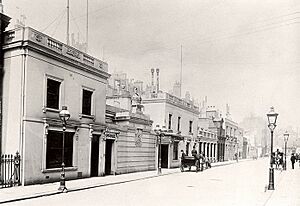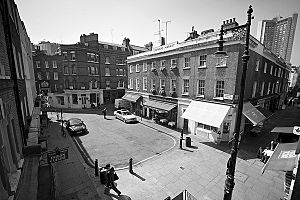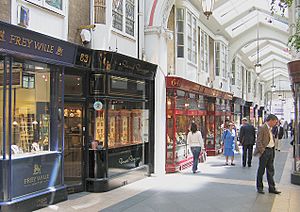Mayfair facts for kids
Quick facts for kids Mayfair |
|
|---|---|
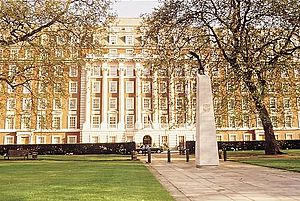 The Biltmore Mayfair overlooking Grosvenor Square |
|
| OS grid reference | TQ285807 |
| Ceremonial county | Greater London |
| Region | |
| Country | England |
| Sovereign state | United Kingdom |
| Post town | LONDON |
| Postcode district | W1 |
| Dialling code | 020 |
| EU Parliament | London |
| UK Parliament | |
Mayfair is a famous and very expensive area in London, England. It is located in the City of Westminster and is part of Central London and the West End. Mayfair is surrounded by well-known streets like Oxford Street, Regent Street, Piccadilly, and Park Lane. It is known as one of the most expensive places to live in the world!
This area was once just open fields until the early 1700s. It became famous for a yearly event called the May Fair. This fair happened from 1686 to 1764 in what is now Shepherd Market. Over time, the fair became very rowdy and was eventually stopped. The Grosvenor family, who later became the Dukes of Westminster, bought the land. They started to build fancy houses and squares like Hanover Square, Berkeley Square, and Grosvenor Square.
By the late 1700s, Mayfair was full of expensive homes for rich families. Unlike some other parts of London, it has always stayed a very wealthy area. In the 1900s, many large houses became offices for companies or embassies. Today, Mayfair still has lots of fancy homes, luxury shops, great restaurants, and amazing hotels along Piccadilly and Park Lane. It's so well-known for being expensive that it's the most costly property on the London Monopoly board!
Contents
Exploring Mayfair's Location
Mayfair is located in the London Borough of Westminster. It includes historical areas owned by families like the Grosvenor family. Mayfair is bordered by Park Lane to the west, Oxford Street to the north, Regent Street to the east, and Piccadilly to the south.
You'll find beautiful parks around Mayfair. Both Hyde Park and Green Park are right next to it. Grosvenor Square is a large, 8-acre square right in the middle of Mayfair. It's a key part of the area, surrounded by many expensive and desirable homes.
Mayfair's Past: A Quick Look
How Mayfair Began
Some people think that the Romans might have settled here before they built Londinium. A theory from the 1950s suggests that a Roman fort was built near Park Street and Oxford Street around 43 AD. This was when Aulus Plautius was waiting for Emperor Claudius. However, there isn't much archaeological proof for this idea.
This area was known as the manor of Eia in the Domesday Book. It was owned by Geoffrey de Mandeville after the Norman Conquest. Later, it belonged to Westminster Abbey until Henry VIII took it over in 1536. Mayfair was mostly open fields until buildings started appearing around Shepherd Market in the late 1600s. This was to make space for the May Fair.
The Famous May Fair
The May Fair was a yearly event held from May 1st to 14th. It started during the time of Edward I when the area was still open fields. The fair moved to what is now Mayfair in 1686. By the 1700s, it was a huge event with showmen, jugglers, and many fairground attractions. People enjoyed bare-knuckle fighting, eating contests, and women's foot races.
However, the May Fair became very wild and noisy. By the time George I was king, it was seen as a public problem. Local residents, including the 6th Earl of Coventry, complained about it. So, the fair was finally stopped in 1764. One reason Mayfair grew with so many fancy houses was to keep out these rowdy activities.
The Grosvenor Family and Their Land

Building in Mayfair started in the 1660s. Sir Thomas Grosvenor, 3rd Baronet married Mary Davis in 1677. She was an heiress who brought 500 acres of land to the family. About 100 acres of this land became Mayfair.
In 1721, the London Journal reported that the land where the May Fair used to be would become a large square with many fine streets and houses. Sir Richard Grosvenor, 4th Baronet asked Thomas Barlow to design the streets. His design of wide, straight streets with a large central square is still mostly the same today. Buildings went up quickly, and by the mid-1700s, the area was covered in houses.
The Grosvenor family still owns much of this land today. They became the Dukes of Westminster in 1874. Chesterfield Street is one of the few streets in Mayfair that still has many original 18th-century buildings.

In 1724, Mayfair became part of the new parish of St George Hanover Square. Grosvenor Square was planned as the main part of the Grosvenor estate. It was built around 1725-1731 and had about 51 plots for houses. It's the second-largest square in London. Many rich families lived there until the mid-1900s. It is still a very fancy address today. Only two original houses remain: No. 9, where John Adams once lived, and No. 38, which is now the Indonesian Embassy. By the late 1800s, the Grosvenor family was one of the richest in Europe.
Mayfair's growth drew wealthy Londoners away from older, less fashionable areas like Covent Garden and Soho. Its success was due to its closeness to the royal court and parks, and its well-planned layout. This helped it stay popular for centuries. The wealthy residents needed stables, coach houses, and servant homes, which were built in the small streets called mews. Some of these mews are now garages or offices.
The Rothschild family, a very rich banking family, owned several properties in Mayfair in the 1800s. Alfred de Rothschild lived at No. 1 Seamore Place.
Mayfair has a long connection with the United States. Pocahontas is believed to have visited the area in the early 1600s. In 1786, John Adams opened the first US Embassy on Grosvenor Square. Theodore Roosevelt was married in Hanover Square, and Franklin D. Roosevelt spent his honeymoon in Berkeley Square. There's even a small park in Mount Street Gardens with benches honoring famous Americans who lived or visited Mayfair.
Mayfair Today

After World War I, it became harder for rich British families to afford their huge Mayfair homes. Many houses were turned into foreign embassies. After much of the City of London was destroyed during the Blitz in World War II, Mayfair attracted many businesses. Many company headquarters moved there.
Today, Mayfair is mostly a business area. Many offices are in converted houses or new buildings. You'll find major company headquarters, investment firms, real estate businesses, and many embassies, including the large US Embassy on Grosvenor Square. Rents here are some of the highest in the world!
But Mayfair still has many expensive homes, exclusive shops, luxury hotels, and great restaurants. Famous buildings include the Italian Embassy, the Royal Academy of Arts, the Handel House Museum, the Grosvenor House Hotel, Claridge's, and The Dorchester.
Famous Buildings in Mayfair
Churches
St George's, Hanover Square was built between 1721 and 1724. Many famous people were married here, including poet Percy Bysshe Shelley in 1814, and Prime Ministers Benjamin Disraeli and H. H. Asquith.
Grosvenor Chapel on South Audley Street was built in 1730. It was used by American soldiers during World War II.
The Mayfair Chapel on Curzon Street was once a popular place for quick, unlicensed marriages. Over 700 marriages happened there in 1742 alone! The Marriage Act 1753 stopped this practice. The chapel was taken down in 1899.
Hotels
Mayfair is home to some of London's most famous hotels.
Brown's Hotel opened in 1837 and is one of London's oldest hotels. Queen Victoria liked to have tea here. In 1876, Alexander Graham Bell made the first successful telephone call in Britain from this hotel. Writers like Rudyard Kipling and Agatha Christie stayed here. Theodore Roosevelt also stayed here and had his wedding reception at the hotel in 1886.
Claridge's started in 1812. It was bought by William Claridge in 1855, who gave it its current name. During World War II, several European royal families in exile stayed at the hotel. A prince, Alexander, Crown Prince of Yugoslavia, was even born there in 1945!
Flemings Mayfair on Half Moon Street opened in 1851. It is the second-oldest independent hotel in London.
The London Marriott Hotel Grosvenor Square was the first Marriott Hotel in Britain. It opened in 1961.
The Grosvenor House Hotel on Park Lane was built in the 1920s. It has over 450 bedrooms and 150 luxury apartments. It was the first hotel in London to have a swimming pool!
The Dorchester hotel opened in 1931. General Dwight Eisenhower used it as his London headquarters during World War II. Prince Philip, Duke of Edinburgh, had his stag night (a party before his wedding) at the hotel before marrying Princess Elizabeth.
The May Fair Hotel opened in 1927. It also has the May Fair Theatre, which opened in 1963.
The Ritz opened on Piccadilly in 1906. It was the first building in London to be built with a steel frame. It is known as one of the most famous and fancy hotels in the world.
Shopping and Art
Mayfair has been home to exclusive shops, hotels, restaurants, and clubs since the 1800s. The area around Bond Street is also famous for its many art galleries and international auction houses like Bonhams, Christie's, and Sotheby's.
Since the early 1800s, tailors have set up shops on Savile Row in Mayfair. They were attracted by the wealthy residents. The first tailor to move there was Henry Poole & Co in 1846. Savile Row became known worldwide for its amazing men's suits and tailoring.
Gunter's Tea Shop was a popular place to buy cakes and ice cream in the 1800s. It was famous for its multi-tiered wedding cakes.
Mount Street has been a popular shopping street since Mayfair was first built. It was largely rebuilt between 1880 and 1900. Today, it has many luxury shops.
Shepherd Market is often called the "village centre" of Mayfair. Its current buildings are from around 1860. They house food shops, antique stores, pubs, and restaurants.
Next to Burlington House is one of London's most luxurious shopping areas, the Burlington Arcade. It was designed in 1819. The arcade was built with tall walls to stop people from throwing trash into the Earl's garden! It was bombed during World War II but was later fixed.
Allens of Mayfair, a well-known butcher shop, started on Mount Street in 1830. It even supplied meat to the Queen! The Mayfair shop closed in 2015, but the company still sells meat online.
South Audley Street is another major shopping street in Mayfair. It has shops selling fine china, silverware, and guns.
Museums and Galleries
Mayfair is known as a global art center because of its many galleries. The Royal Academy of Arts, located in Burlington House, was founded in 1768. It is the oldest fine arts society in the world. Its first president was Sir Joshua Reynolds. The academy holds classes and exhibitions. Famous students include John Constable and J. M. W. Turner. The academy hosts an annual Summer Exhibition, showing over 1,000 modern artworks that anyone can submit.
The Fine Art Society gallery opened in 1876. Other galleries in Mayfair include the Maddox Gallery and the Halcyon Gallery.

The Handel House Museum at No. 25 Brook Street opened in 2001. George Frideric Handel, a famous composer, lived here from 1723 until he died in 1759. He wrote many of his greatest works, like Messiah, in this house. The museum also had an exhibition about Jimi Hendrix, a famous musician, who lived in an apartment next door at No. 23 Brook Street in 1968–69.
The Faraday Museum in Albemarle Street is in a basement laboratory. This is where Michael Faraday did his experiments with magnets and electricity. It opened in 1973 and shows his first electric generator and other notes and medals.
Other Notable Places
Bourdon House is one of the oldest buildings in Mayfair, built between 1723 and 1725. The 2nd Duke of Westminster lived here until he died in 1953.
Crewe House was built in the late 1700s. It is now part of the Saudi Arabian Embassy.
Mayfair has many blue plaques on its buildings. These plaques show where famous people lived. For example, on the corner of Chesterfield Street and Charles Street, you can see plaques for King William IV, Prime Minister Lord Rosebery, writer Somerset Maugham, and fashion icon Beau Brummell.
Getting Around Mayfair
Mayfair doesn't have its own London Underground stations right inside the area. However, there are several stations on its borders. The Central Line stops at Marble Arch, Bond Street, and Oxford Circus along Oxford Street. The Piccadilly line has stops at Piccadilly Circus and Green Park on the southern side. Hyde Park Corner is also nearby.
Down Street tube station opened in 1907 but closed in 1932. During World War II, it was used by the government and even briefly by Winston Churchill and his war cabinet! While there's only one bus route directly in Mayfair, the 24-hour route C2, many other bus routes run along the main roads around the area.
See also
 In Spanish: Mayfair para niños
In Spanish: Mayfair para niños



